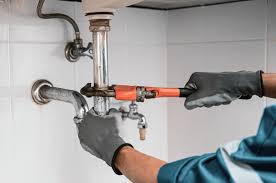A home’s plumbing system is one of its most vital components, yet it’s often overlooked until something goes wrong. From faucets to water heaters, every element plays a role in how efficiently water moves through the home. Improving plumbing efficiency isn’t just about saving money—it’s also about conserving water, reducing wear on fixtures, and maintaining consistent performance. Small inefficiencies, such as slow leaks or outdated pipes, can lead to significant waste over time. Understanding how to optimize your plumbing system helps ensure reliability and sustainability for years to come, while lowering utility bills and preventing costly damage.
Understanding the Basics of Plumbing Efficiency
Plumbing efficiency starts with understanding how water is distributed and used throughout the home. When water travels long distances through aging or narrow pipes, pressure drops and delivery slows, causing fixtures to work harder and waste more water. Efficient systems, on the other hand, balance flow and pressure while minimizing heat loss from water heaters. Modern plumbing designs often incorporate direct routes and pressure-regulated valves that reduce strain on pipes and pumps. In many homes, simple updates—like upgrading faucets, replacing old seals, or insulating water lines—can have a noticeable impact on performance. The goal is to maintain water flow smoothly with minimal energy consumption and maximum reliability. Once these basics are in place, homeowners can identify which components require attention for improved functionality.
Upgrading Fixtures and Appliances for Better Performance
One of the simplest ways to boost plumbing efficiency is by replacing outdated fixtures and appliances with modern, water-saving alternatives. Low-flow faucets and showerheads use advanced aerators that maintain intense pressure while reducing overall water consumption. Similarly, dual-flush toilets and efficient dishwashers help minimize waste without sacrificing convenience. Even minor upgrades, such as motion-sensor faucets, prevent excess water flow during daily routines. Energy-efficient water heaters and tankless systems also contribute significantly to savings. These units provide hot water on demand, reducing standby heat loss and improving household performance. For businesses, such as an Audubon office, upgrading restrooms and breakroom fixtures can lead to significant reductions in utility costs while supporting environmental goals. Modern plumbing technology is designed to strike a balance between comfort, sustainability, and long-term value, making fixture upgrades a practical and rewarding step toward efficiency.
Preventing Leaks and Conserving Water
Leaks are one of the most common causes of inefficiency in any plumbing system. Even a small drip can waste hundreds of gallons of water over time. Regular inspections help identify hidden leaks behind walls, under sinks, and in outdoor piping. Detecting them early prevents structural damage and mold growth while keeping utility bills manageable. Common problem areas include aging joints, worn-out washers, and deteriorating seals. Advanced leak detection systems now utilize sensors to monitor water flow and automatically shut off the supply when irregularities are detected. Maintaining fixtures properly and tightening loose fittings can extend the lifespan of the system. Addressing minor leaks immediately not only conserves water but also protects the home’s foundation from long-term moisture exposure. Preventive maintenance becomes a key habit in ensuring sustainable and cost-effective plumbing efficiency throughout the year.
Maintaining Water Heaters for Maximum Efficiency
The water heater is one of the largest energy consumers in most households. Over time, sediment buildup inside the tank reduces heating efficiency and increases energy demand. Flushing the tank annually helps remove this buildup and maintain optimal performance. Installing a timer or intelligent control system allows homeowners to regulate when the water heater operates, reducing unnecessary heating cycles. Insulating both the tank and the connecting hot water pipes can minimize heat loss, ensuring the water remains warm for a longer period. For households that frequently run out of hot water, upgrading to a larger or tankless unit can improve both comfort and energy efficiency. Temperature settings should also be reviewed—lowering the thermostat by just a few degrees can yield noticeable savings without compromising comfort. Proper water heater care is a simple yet effective way to boost the overall efficiency of a plumbing system.
Improving Water Pressure and Flow Balance
While intense water pressure may feel convenient, excessive pressure can stress pipes, cause leaks, and reduce the lifespan of fixtures. Installing a pressure-reducing valve helps maintain balance by limiting the pressure entering the home. Consistent pressure ensures that all fixtures receive an even supply without overwhelming weaker connections. Homeowners should also clean aerators and showerheads periodically, as mineral buildup can restrict water flow and cause the system to work harder. In areas with hard water, a water softener helps reduce mineral deposits, protecting both plumbing and appliances. Balancing water pressure not only enhances daily comfort but also prevents premature wear on key components. Maintaining this equilibrium ensures the entire system operates smoothly, extending its lifespan and reducing maintenance costs over time.
Insulating Pipes and Preventing Energy Loss
Pipe insulation is an often-overlooked measure that can significantly improve efficiency. Exposed pipes—particularly in basements, attics, or exterior walls—lose heat quickly, forcing water heaters to work harder. Wrapping pipes in insulating material reduces heat loss and prevents freezing during colder months. Insulated pipes also deliver hot water more quickly, minimizing the time spent waiting at taps and reducing overall water waste. For cold-water lines, insulation helps prevent condensation that can cause corrosion and moisture damage. The material is inexpensive, easy to install, and provides immediate benefits in both comfort and performance. This simple upgrade can lead to long-term savings by reducing energy demand and preserving the system’s integrity.
Adopting Preventive Maintenance Habits
A proactive maintenance approach is crucial for maintaining the efficiency of any plumbing system. Scheduling periodic inspections ensures that potential issues are detected early. Homeowners can monitor water usage through smart meters, which provide detailed data on consumption patterns and help identify wasteful habits. Cleaning drains regularly prevents buildup that can slow flow and increase pressure within pipes. Professional maintenance services can include camera inspections of underground lines to detect clogs or damage before they cause significant issues. Simple habits—like turning off taps completely, fixing leaks promptly, and maintaining fixture seals—have a compounding effect over time. When combined, these practices promote both reliability and cost savings, ensuring the system remains efficient for years to come.
Read More: https://acubi.us/enhancing-home-comfort-with-city-sound-ltd-the-benefits-of-secondary-glazing/
Building Long-Term Plumbing Efficiency
Improving plumbing efficiency is about more than reducing water bills—it’s about creating a sustainable and reliable system that supports daily life without waste. From upgrading fixtures to maintaining water heaters and balancing pressure, each step contributes to a stronger, more efficient infrastructure. Preventive care and regular maintenance extend the system’s lifespan while reducing the risk of costly breakdowns. Whether in a small home or a large commercial building, efficient plumbing ensures that every drop of water is used effectively. By investing time and effort into optimizing performance, homeowners can achieve lasting savings, greater comfort, and a responsible approach to resource conservation that benefits both the household and the environment.



